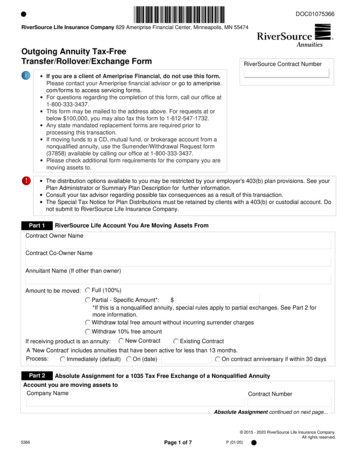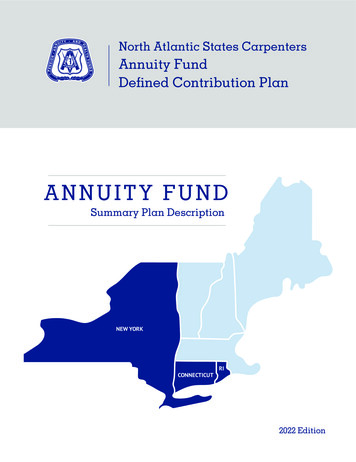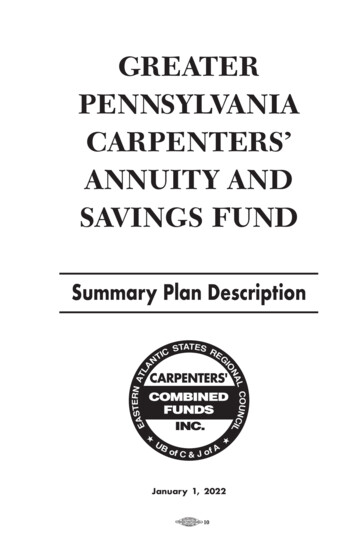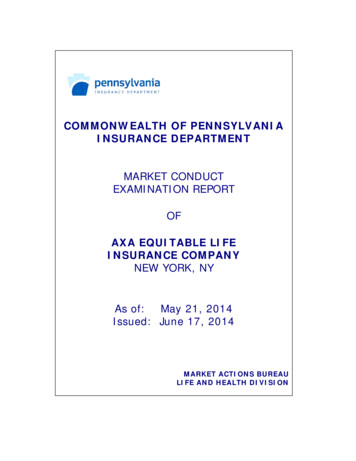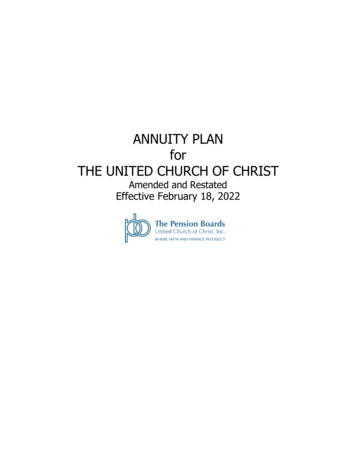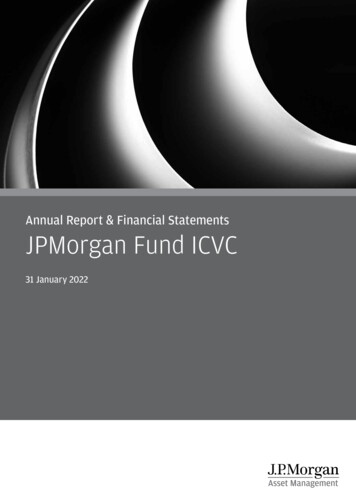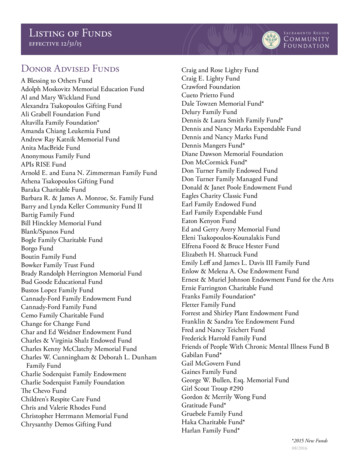
Transcription
Annuity FundSummary Plan DescriptionLocal 14-14B
Table of ContentsINTRODUCTION2ELIGIBILITY AND PARTICIPATIONEligibilityWhen Participation BeginsNaming a Beneficiary3333HOW THE PLAN WORKSEmployer ContributionsVoluntary ContributionsVestingRolloversIRS Limits444455INVESTING IN YOUR ACCOUNTDirecting Your InvestmentsYour Investment OptionsExcessive Trading RulesStaying on Top of Your AccountSafeguarding Your PINAbout Your Investment DecisionsRepresentative Responsible for Providing PlanInvestment InformationValuing Your Account6666677WHEN YOU CAN RECEIVE YOUR BENEFITWhen Payment is MadeApplying for BenefitsIf You’re Reemployed After You Retire9999HOW BENEFITS ARE PAIDNormal Forms of PaymentOptional Forms of PaymentSmall BenefitsHow to Elect an Optional Form of PaymentIF YOU DIE BEFORE RECEIVINGYOUR BENEFITMarried ParticipantsUnmarried ParticipantsDirect Rollovers to Eligible RetirementPlans for Non-Spouse Beneficiaries88LOANSTypes of LoansHow Much You Can BorrowRepaying Your LoanInterest on Your LoanApplying for a LoanIf You Default13131314141414WITHDRAWALS WHILE YOU’RESTILL WORKINGHardship Withdrawal Option1515OTHER INFORMATION YOUSHOULD KNOWClaims and AppealsYour Rights Under the Uniformed ServicesEmployment and ReemploymentRights ActPension Benefit Guaranty CorporationHow Benefits Can Be DelayedAssignment of BenefitsCompliance with Federal LawAmendment and Termination of the PlanRecovery of OverpaymentYour Disclosures to the PlanPlan AdministrationDiscretionary Authority of theBoard of TrusteesEmployer OUR RIGHTS UNDER THE EMPLOYEERETIREMENT INCOME SECURITY ACTInformation About Your Plan and BenefitsPrudent Actions by Plan FiduciariesEnforce Your RightsAssistance with Your Questions1919191919121212PLAN FACTS2012Annuity Fund SPD 1
IntroductionThe International Union of Operating Engineers Local 14-14B Annuity Fund hasestablished a Plan that is designed to provide you with a valuable supplement to theretirement income you may receive from other sources, such as the Pension Fund andSocial Security. Here are some of the highlights of how the Plan works.This booklet is the SummaryPlan Description (SPD)for the Annuity Fund as ofJanuary 1, 2018. It replaces andsupersedes all prior SPDs. It’smeant to help you understandhow the Plan works. It doesn’tchange the official rules andregulations in the official PlanDocument or other documents,including trust agreements andthe collective bargainingagreements establishing thePlan. Rights to benefits aredetermined only by referringto the full text of the officialPlan Document (available foryour inspection at the FundOffice) or by official action ofthe Board of Trustees. If thereis any conflict between theterms of the official rules andregulations of the AnnuityFund or the Plan it hasadopted and this SummaryPlan Description, the officialrules and regulations shallcontrol. In addition, the Boardof Trustees reserves the right,in its sole and absolutediscretion, to amend or endthe Plan at any time, subjectto the terms of the applicablecollective bargainingagreements.2 Annuity Fund SPD“Retirement” means withdrawal from employment as an Operating Engineeror any other type of Building Trades’ craftsman. Y ou don’t have to contribute—although you can if you want to. Your employer makescontributions to the Fund on your behalf, as required by your collective bargaining agreement.You may add up to 10% of your annual after-tax earnings as voluntary contributions, up to amaximum amount set each year by the Internal Revenue Service. Y ou have your own Account. Once you become a Plan participant, the Plan sets up anIndividual Account in your name. The value of your Account at any time depends on theamount of employer contributions and voluntary contributions, adjusted for investment gainsand losses. Y ou are immediately 100% “vested” in the value of your Account. This means that youalways have a right to the full value of your Account in accordance with the distribution rulesof the Plan. Y ou decide how your Account will be invested. You choose which of the Plan’sprofessionally managed investment options to invest in. Y ou pay no taxes on your Account until you receive it. Your Account has the opportunityto grow on a tax-advantaged basis. You pay no tax on the contributions your employer makes,nor any investment income your Account may earn, until you take money out of your Account. Y ou may apply for payment of your benefit when you reach age 62 and retire under theIUOE Local 14-14B Annuity Plan, or when you leave covered employment (that is, you workfewer than 400 hours in covered employment during any consecutive 12-month period). Y our Plan benefit can also be paid to you if you become “totally and permanently disabled,”or to your surviving spouse or other beneficiary if you die before you receive your benefit. Y our benefit can be paid as an annuity that provides monthly income for life, equalinstallments for up to ten years, a single lump-sum payment, quarterly installments equal tointerest and/or investment income earned during the prior quarter, or in any combination ofthese options. Y ou can borrow from your Account. The Plan’s loan features give you access to the moneyin your Account for specific purposes while you are working. Y ou may be eligible for a hardship distribution. The Plan’s hardship distribution option givesyou access to a portion of your money in the event that you suffer an immediate and heavyfinancial need and you are not otherwise eligible for a loan.
Eligibility and ParticipationEligibilityYou are eligible to participate in the Plan if you are covered by a collective bargainingagreement that requires your employer to contribute to the Plan on your behalf. You’re alsoeligible if you are a full-time employee of the International Union of Operating Engineers Local14-14B or the Fund Office and are not represented for collective bargaining purposes byanother union.Employers that contributeto the Fund are known as“contributing employers.”When Participation BeginsYou become a participant on the date contributions are first made to the Annuity Fund onyour behalf. (Please see page 4 for more information on Benefit Fund Stamps.) Once you’re aparticipant, the Plan will establish an Individual Account in your name.Naming a BeneficiaryOnce you become a Plan participant, you’ll be asked to name a beneficiary or beneficiaries toreceive your Account balance if you die before receiving all of it. You do this by completing aBeneficiary Designation Form and returning it to the Fund Office. Forms are available from theFund Office.Subject to the spousal consent rules described below, you may name any person or personsyou choose as your beneficiary. You may also change your beneficiary designation at any timeby submitting a new form to the Fund Office. In all cases, you must use the Plan’s officialBeneficiary Designation Form and it must be properly completed.If you fail to name a beneficiary, or if your beneficiary dies before you, then any unpaidbenefit will be paid to your surviving spouse or, if you don’t leave a surviving spouse, then toyour estate.Spousal consent. If you’re married, you may name a beneficiary other than your spouse onlyif your spouse consents in writing and such consent is witnessed by a notary public. Completedetails on this process are available from the Fund Office.Please contact the FundOffice whenever you oryour spouse have a changein name, address, telephonenumber or e-mail address, ormarital status (marriage, legalseparation or divorce), or ifyou or your spouse die.Annuity Fund SPD 3
How the Plan WorksEmployer Contributions“Benefit Fund Stamps” meanthe Stamps distributed toyou with your paycheck by aContributing Employer. TheseStamps represent the amountyour employer is requiredto contribute to the Plan onyour behalf under the termsof the collective bargainingagreement.Pursuant to your employer’s collective bargaining agreement with Local 14-14B, your employeris required to purchase Benefit Fund Stamps from the Fund Office which include the amountyour employer has contributed to the Plan on your behalf. On each payday, your employeris required to distribute Benefit Fund Stamps to you in an amount equal to the contributionobligation specified in the collective bargaining agreement. Upon receipt of these stamps, pastethem in the stamp book that is provided to you by the Fund Office. You are solely responsiblefor the safekeeping of the stamps you are given. These Benefit Fund Stamps are not transferableand are only credited to the Individual Account of the employee who earned them whileworking for his or her employer.You will receive credit for the contributions made on your behalf based upon the hours youworked for your employer in accordance with the collective bargaining agreement.Benefit Fund Stamp Books. Submit your stamp book or books to the Fund Office during eachredemption period. There are three redemption periods a year: March 1 through March 31; July 1 through July 31; and November 1 through November 30.If you do not submit your stamp book to the Fund Office in person, mail it in via registeredmail and insure the package for its full monetary value.Voluntary Contributions“Compensation” meansthe wages paid to you foremployment covered underthe Plan that would bereported as income onForm W2.For each year in which you submit a stamp book, you can contribute up to 10% of your aftertax compensation as voluntary contributions to the Plan, subject to IRS limitations. To make avoluntary contribution, complete and submit the first page of your Benefit Fund stamp book tothe Fund Office. You may submit your election to the Fund Office during the three redemptionperiods in March, July or November, or contact the Fund Office after the final closeout of theNovember redemption to inquire about your maximum eligible voluntary contribution based onIRS regulations.Voluntary contributions are held in your Individual Account and you control how they areinvested. Since all voluntary contributions are taxed in the year you make them, you will not betaxed again when you receive payment. However, you will pay taxes on the interest earned onyour voluntary contributions when those investment gains are distributed to you.VestingYou are always 100% vested in, or entitled to, the value of your Account. This means youdon’t have to complete any special period of service to receive your Account value if youremployment ends before retirement. However, keep in mind that even though your Accountbalance is vested, there are limitations on when you can withdraw money from your Account(see page 15 for more information). The fact that you have an Individual Account in the Plan isnot a guarantee of employment and does not give you any right, title or interest in the AnnuityFund, its assets or your Individual Account, except at the times and under the conditionsspecified in the Plan’s Rules and Regulations.4 Annuity Fund SPD
RolloversIf you are a new participant and just received (or are about to receive) a taxable distributionfrom another qualified reciprocal IUOE retirement plan, which is qualified under Section 401(a)of the Internal Revenue Code, you can transfer it to this Fund. Taxes on the money you rollover are deferred until the rollover is paid out to you. Except in the case of a direct rollover(that is, a distribution that goes directly from your previous plan to this Plan), all rollovers tothe Plan must be completed within 60 calendar days after you get your distribution. Rolloversmust be approved and you may be asked to provide proof that it meets all of the Plan’srequirements. If you are considering a rollover contribution, contact the Fund Office.You are always 100% vested inyour rollover contributions.IRS LimitsCompensation limits. The Internal Revenue Code limits the amount of compensation thePlan can consider in determining voluntary contributions. This limit is set by the IRS on anannual basis.Non-discrimination rules. In addition, the Internal Revenue Code requires the Plan to passspecial non-discrimination tests to ensure that it does not discriminate in favor of highly paidemployees. You will be notified if your contributions must be adjusted because of these tests.Annuity Fund SPD 5
Investing in Your AccountDirecting Your InvestmentsYour initial investment election. When your Plan participation starts, you’re asked to make aninvestment election (sometimes also called your “investment mix”). You do this directly throughPrudential, as described in its welcome kit. You can allocate the money in your Account anyway you like, as long as your allocation is in 1% increments. Whatever allocation you electremains in effect until you change it.Making changes. You can shift money in your Account from one investment option to another.This is known as “re-allocating” your Account. You can re-allocate whenever you like, but youmust do it in 1% increments.It’s a good idea to check yourinvestment allocation fromtime to time; see “Staying onTop of Your Account” fordetails.You can make daily investment changes through the Interactive Voice Response (IVR) systemor by logging on to the following website: www.local14funds.org. Your change generally willtake effect on the same day if you complete your call by 4 PM Eastern time on a business day(a day that the New York Stock Exchange is open for business). Otherwise, your change will beeffective the next business day.If you don’t make an election. If you fail to make an investment election, the money in yourAccount will automatically be invested in the Plan’s default option, also known as a “QualifiedDefault Investment Alternative” or “QDIA.” The QDIA is currently the Vanguard TargetRetirement Date Funds. You can get more information about this QDIA from Prudential.Your Investment OptionsThe investment options the Plan currently offers are described in Prudential’s materials. Youshould read up on each option and get a prospectus from Prudential before making yourinvestment decisions. It’s also important to understand that how the options have performed inthe past is no indication of how they will perform in the future.Excessive Trading RulesDue to the scrutiny placed upon plan sponsors and fiduciaries by the Securities and ExchangeCommission (SEC) to curb market timing and excessive trading, investment options offeredunder the Plan are subject to excessive trading rule policies.Large short-term cash flows in and out of an investment option can disrupt portfolio strategiesand costs. To protect the interests of, and maintain a standard of fairness among shareholders,this policy monitors exchanges in and out of the investment options under the Plan. Althoughyou can exchange between investment options freely in the Plan (as discussed above), you mustdo so in conjunction with each option’s excessive trading policy. These policies are outlined ineach option’s Prospectus or Fact Sheet. Please be sure to read them carefully.Staying on Top of Your AccountTwo automated systems provide easy access to your Account information: I nteractive Voice Response Service (IVR) is a toll-free, 24-hour automated phone line thatallows you to access information about your Account and perform certain transactions using atouch-tone telephone. To access the IVR, call 1-800-253-2287.6 Annuity Fund SPD
w ww.prudential.com/online/retirement provides you with the ability to access Accountinformation and make transactions online. The website is available 24 hours a day, sevendays a week.You’ll need your Personal Identification Number (PIN) to access the automated systems. Youwill also receive Account information through financial statements that are mailed to your homefour times a year. Both the IVR system and the website allow you to: check your Account balance request a withdrawal transfer between investment options request a distribution track the performance of your investments Change your PIN get information on loans and hardship distributions.Your Participant Financial Statement. The Plan’s fiscal year runs from January 1 throughDecember 31. Plan statements are mailed four times a year. Your quarterly statement will showall of your Account balances and activity, including your employer’s contributions, investmentresults, transfers (if any), etc. You’ll also get a printed confirmation of any investment changeyou make (normally mailed within a few days after you make the change).Safeguarding Your PINYour PIN is like the combination to your Plan safe. It’s a good idea to safeguard your PIN at alltimes. Here are some pointers to help you protect your PIN: Don’t share your PIN with anyone. Memorize your PIN. If you must write it down, don’t label the number as your Plan PIN. D on’t choose a PIN that is easily guessed, such as your telephone number, Social Securitynumber or birthday. D on’t use consecutive numbers (such as 123456) or the same number repeated (suchas 444444). Don’t use your PIN when someone else can see you keying it in. C hange your PIN from time to time. Change your PIN immediately if you suspect your PINhas been exposed to others or that an unauthorized person has tried to access your Account.About Your Investment DecisionsThe Trustees decide which investment options to offer under the Plan. The Plan may offeror stop offering any option at any time. Please read carefully the separate investment optionmaterials, which include a description and Prospectus or Fact Sheet of each option, todetermine which option or combination of options is right for you. These materials are availablefrom Prudential or the Fund Office.While the Plan’s Trustees decide which investment options to make available to you under thePlan, it’s up to you to select the options in which you will invest your Account. The Fund Officecan provide you with information on how the investment options work but cannot give youinvestment advice.Annuity Fund SPD 7
Please remember that any investment carries a degree of risk. The annual rate of return onyour investment will vary depending on the options in which you invest. How an option hasperformed in the past does not guarantee future results.It is your responsibility to monitor the performance of the investment options availableunder the Plan and to make investment elections that meet your own financial goals. You areresponsible for your investment choices. Neither the Trustees, Prudential nor any representativeof the Plan is responsible for any losses that result from your investment decisions.Representative Responsible for Providing PlanInvestment InformationYou change your investmentelections by contactingPrudential.Prudential has been designated to provide the information required under ERISA Section404(c) and, upon request, will make available the following information to Plan participants withrespect to the Plan’s investment options: a description of the annual operating expenses of each investment alternative (includinginvestment management fees, transaction costs and other costs that may reduce the rate ofreturn of such investment alternative) and a description of the amount of any such expensesexpressed as a percentage of average net assets of the investment alternative; c opies of Prospectuses, Fact Sheets, financial statements and reports, and any other relevantmaterials relating to the investment alternatives available under the Plan to the extent suchinformation is provided to the Plan; a list of the assets comprising the portfolio for each investment alternative, the value ofeach such asset (or the proportion of the investment alternative that it comprises) and, withrespect to each investment alternative that is a fixed-rate investment contract issued by abank, savings and loan institution or an insurance company, the name of the issuer of thecontract, the term of the contract and the rate of return on the contract; i nformation with regard to the value of shares or units of investment alternatives, as wellas on the past and current investment performance of each alternative, determined, net ofexpenses, on a reasonable and consistent basis; and i nformation with regard to the value of shares or units of the investment options held inyour Account.Valuing Your AccountAccount values are determined each day that the New York Stock Exchange is open forbusiness. The value of your Individual Account will reflect all of the following factors: employer contributions made on your behalf investment gains or losses your own voluntary contributions loans and loan repayments rollover contributions distributions.Administrative expenses that are allocable to your Individual Account will be paid from yourIndividual Account.8 Annuity Fund SPD
When You Can Receive Your BenefitYou’re eligible to receive the full value of your Account in any of the following circumstances: y ou reach age 62 and retire under the International Union of Operating Engineers Local14-14B Annuity Fund; y ou work fewer than 400 hours in covered employment during any consecutive12-month period; y ou are permanently and totally disabled and cannot continue work at any type ofemployment regularly performed by members of the Union; or you die.When Payment is MadePayment will begin as soon as administratively possible after the Fund Office receives a properlycompleted application form. If your Account balance is more than 1,000, you may deferpayment, but in no case may you defer payment beyond April 1 of the year following the yearyou reach age 70½.Taxation of BenefitsThe Fund Office will provideyou with additional informationconcerning taxes whenyou are eligible to receivea distribution. It’s a goodidea to consult a tax advisorbefore electing to receive adistribution from the Plan.Applying for BenefitsIn order to receive benefits, and to elect an optional form (as described on page 10), you mustsubmit a completed application form to the Fund Office. Please note that if you’re married,your benefit will automatically be payable as a 50% joint and survivor annuity (the automaticform of payment for married participants). As an alternative, you may elect to receive yourbenefit as a 75% joint and survivor annuity. Please note that your spouse must consent inwriting if you elect any form of payment other than the 50% or 75% joint and survivor annuity,and his/her consent is witnessed by a notary public. In other words, if you’re married and wantto elect an optional form of distribution, you need to submit both a completed application formand your spouse’s notarized consent to reject the 50% or 75% joint and survivor annuity.Benefit payments can’t start until at least 30 days after the Plan advises you of the availablepayment options. The Plan will send you and your spouse (if any) a written explanation ofthe payment options at least 30 days, but no more than 180 days, before you begin receivingbenefits. However, you (and your spouse, if any) may consent to an earlier distribution at anytime at least 7 days after you receive the explanation of payment options. In either case, youmay change your payment election at any time before payment starts or is made.If You’re Reemployed After You RetireIf you retire but later return to work as an Operating Engineer before you’ve received the fullvalue of your Individual Account, distribution of your Account from your prior employmentwill not be affected by this reemployment. In addition, you will continue to earn Annuitycontributions for this post-retirement employment.Annuity Fund SPD 9
How Benefits are PaidBenefits are normally paid depending on the value of your Account and whether you’remarried or single at the time that payment star ts.Normal Forms of PaymentIf you’re married, your Account balance will be paid as a 50% or 75% qualified joint andsurvivor annuity depending on the option you elect. These forms of payment will pay you a fixedmonthly amount for your life, with either 50% or 75% of that amount continuing to your spouseupon your death, if he or she survives you. (If your spouse dies before you but after paymentsstart, your monthly payments continue in the same amount that you received before yourspouse died.) However, if you are married but don’t want your benefit paid as a 50% or 75%qualified joint and survivor annuity, and your spouse consents in writing before a notary public,you may elect a single life annuity or one of the optional forms of payment described below.If you’re not married, your Account balance normally is paid as a single life annuity. This formof payment will pay you a monthly payment for as long as you live, and then payments stop.No benefits are paid after your death, except for payment of your remaining balance to yourdesignated beneficiary. If you prefer, you may elect one of the optional forms of paymentdescribed below.Please note that if your benefit is to be paid in the form of an annuity, the Plan will use yourAccount balance to purchase an individual annuity contract from a legal reserve life insurancecompany. Before it does, the Plan will let you know, in writing, the monthly dollar amount ofthe benefit that would be payable, based on your Account balance and your age (and yourspouse’s age, if applicable).You will not receive payment without your written consent before your normal retirementdate (age 62). If you take a distribution from your Account before you reach age 59½ for anyreason other than your death or retirement after age 55, the distribution may be subject to anadditional 10% excise tax.Optional Forms of PaymentThese optional forms of payment are available under the Plan. S ingle lump-sum payment. You receive your entire Account balance all at once in a singlepayment. Anyone can elect this form of payment. Q uarterly installment payments of investment earnings. You receive quarterly interestonly payments until you reach the date you are required to start taking distribution fromyour Account (April 1 of the calendar year following the year in which you reach age 70½).Quarterly payments will equal the interest and/or investment earnings on your IndividualAccount earned in the prior quarter. You can elect this form only if you retire at or after age62 or become permanently disabled and cannot work at any of the types of employmentregularly performed by Local 14-14B members.10 Annuity Fund SPD
O ptional fixed annuity form. You receive payment through the purchase of an annuity thatis payable in quarterly installments for a fixed period of up to 10 years. You specify theperiod over which the annuity is to be paid. Under Federal law, however, the maximumperiod over which the annuity may be paid cannot exceed your life or the joint lives ofyou and your beneficiary. You can elect this form only if you retire at or after age 62 orbecome permanently disabled and cannot work at any of the types of employment regularlyperformed by Local 14-14B members.Small BenefitsA special provision applies to small balances. If your Account value is 1,000 or less, yourbenefit will automatically be paid in a single lump sum.How to Elect an Optional Form of PaymentIf you want to elect an optional form of payment, you must apply for it in writing. If you’remarried, your spouse must consent in writing to your rejection of the 50% or 75% qualifiedjoint and survivor annuity, and his or her consent must be witnessed by a notary public. Likewise,if you’re married and wish to name a beneficiary other than your spouse, your spouse mustconsent in writing to the designation and the consent must be witnessed by a notary public.Within a period of no more than 180 days and no fewer than 30 days before benefit paymentsbegin (your Annuity Starting Date), the Annuity Fund will provide you and your spouse (if any)with a written explanation that includes: a descripton of the Plan’s normal and optional payment forms and the financial effect ofelecting an optional form; your right to make and the effect of an election to waive the normal form of payment; your spouse’s right to consent to any election of an optional form of payment; y our right to revoke your election during the 30-180 day election period before your AnnuityStarting Date and the effect of that revocation; and your right to defer any distribution and the consequences of failing to defer any distribution.Contact the Fund Office for more information regarding this written notice.Required Minimum DistributionIf you choose a form of payment other than a lump-sum payment, you are requiredto receive a minimum amount of benefits. U.S. Treasury regulations require thatyou receive a minimum distribution each year beginning with April 1 of the calendaryear following the year you reach age 70½.The minimum distribution calculation is determined by a formula, which is based onyour age, remaining life expectancy and the amount of your Individual Account.Annuity Fund SPD 11
If You Die Before Receiving Your BenefitIf you die before payment of your benefit star ts, payment of your Account balance dependson whether you’re married or single at the time of your death.Married ParticipantsIf you were married at the time of your death, your spouse is automatically your beneficiaryfor 50% or 75% of your Account balance. Your spouse may elect to receive payment in a singlelife annuity that provides lifetime monthly income for your spouse, a single lump sum or underany other optional form of payment the Plan offers. However, your spouse cannot elect anannuity payable over the joint lives of your spouse and another person.No matter which payment method your surviving spouse chooses, he or she may elect to deferpayment of this benefit until any specified date that is no later than December 31 of the yearin which you would have reached age 70½ or December 31 of the year following the year youdied, which
2 Annuity Fund SPD The International Union of Operating Engineers Local 14-14B Annuity Fund has established a Plan that is designed to provide you with a valuable supplement to the retirement income you may receive from other sources, such as the Pension Fund and Social Security. Here are some of the highlights of how the Plan works.
